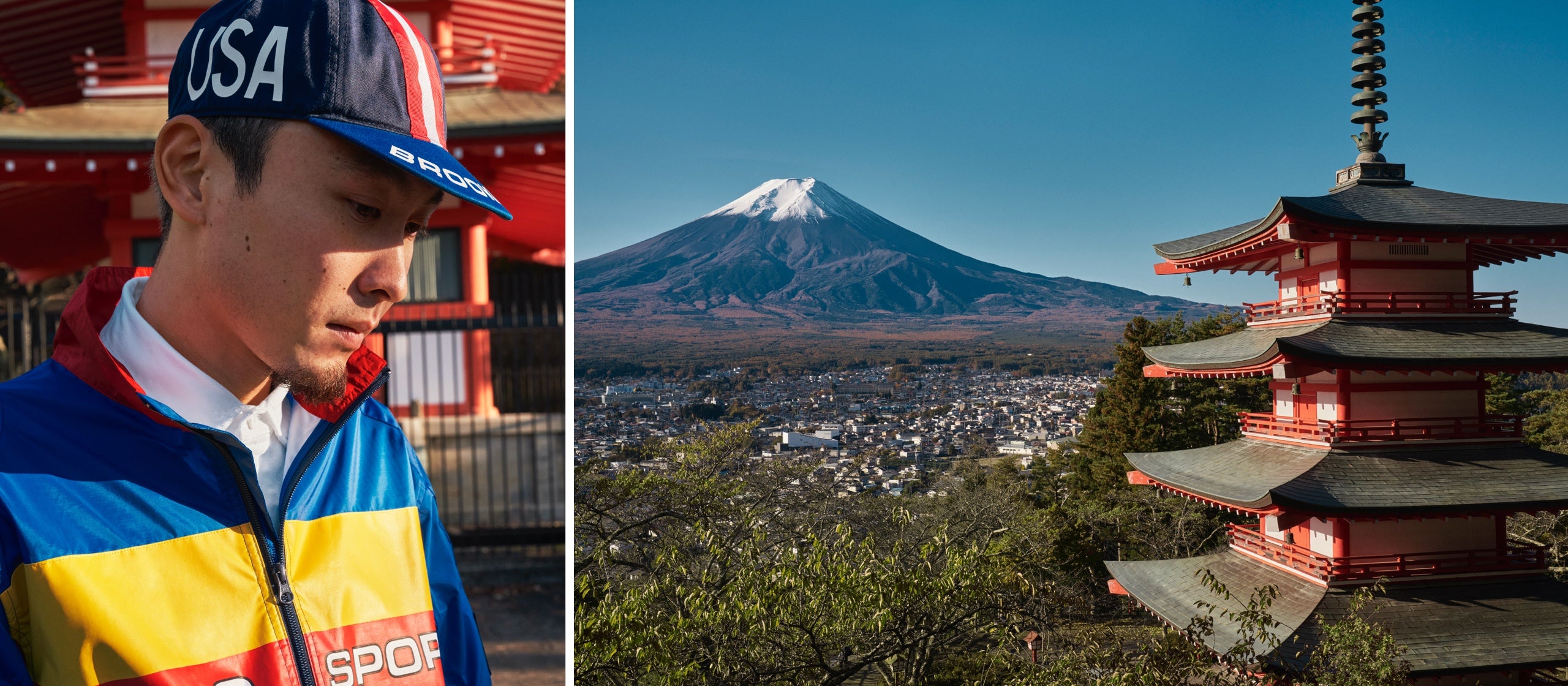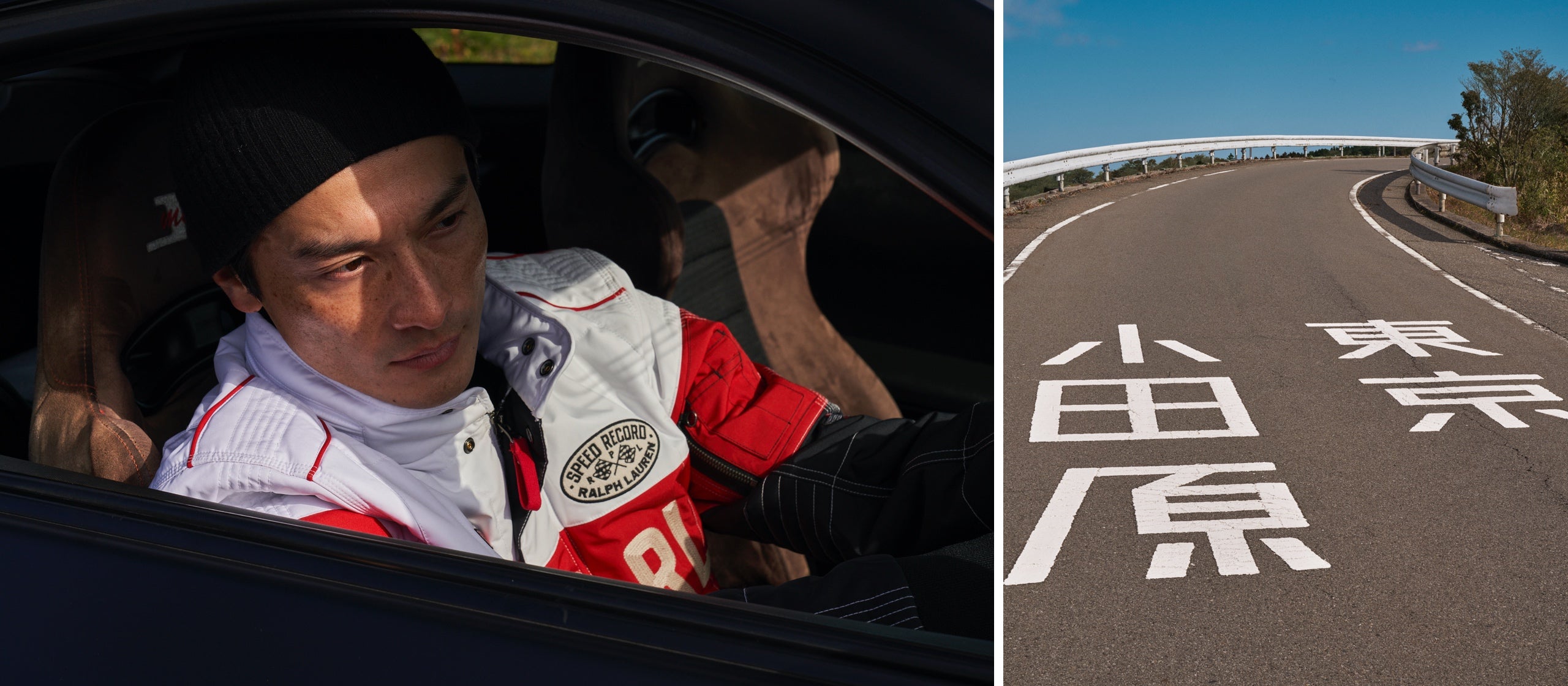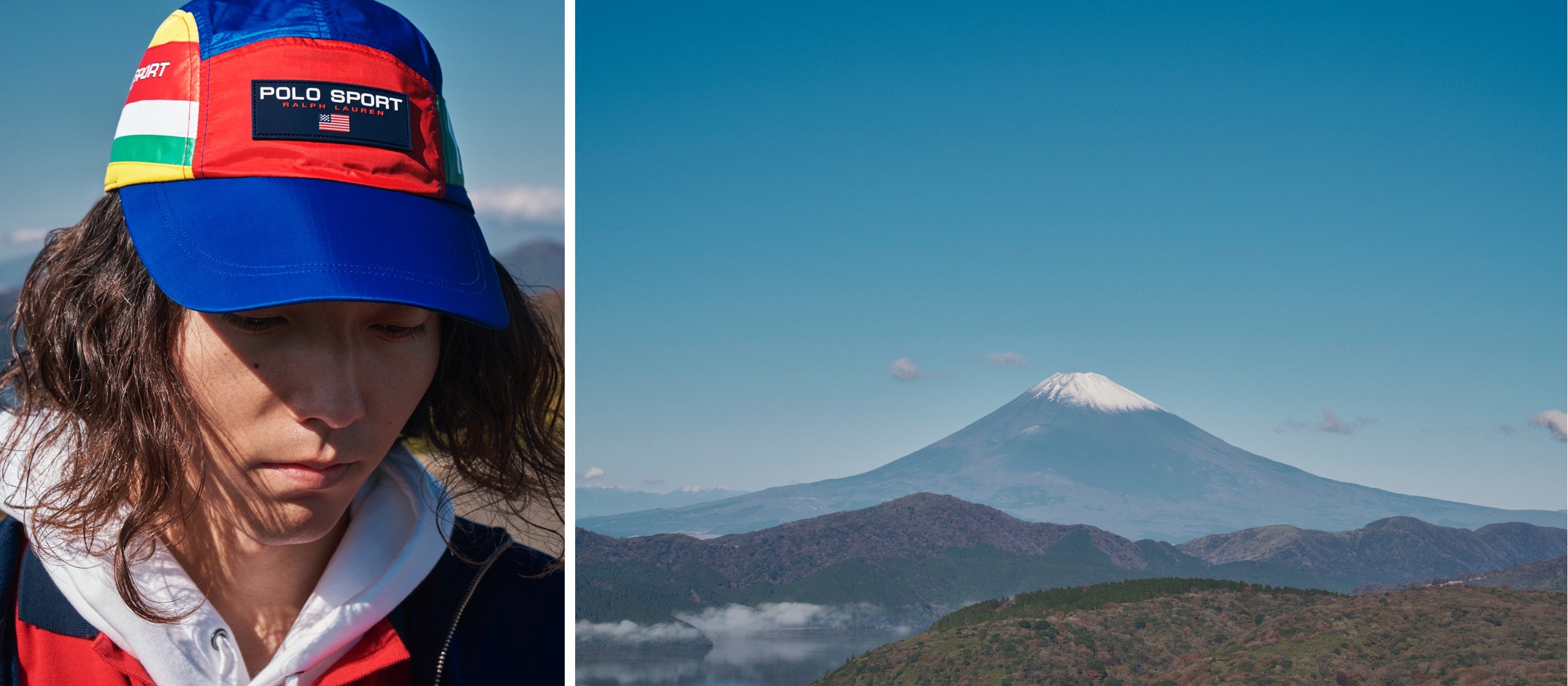
Riders
&
Racers
Behind the scenes with three of the country’s extreme sport athletes—from Ralph Lauren’s first-ever campaign shot in Japan
In its 50-plus years, Ralph Lauren has shot campaigns all over the world—Virginia country estates, Bermuda beaches, New England manors, the California coast, and the cobblestone streets of St. Andrew’s to name just a few. This spring, though, a new location was added to the list—the first time that a Polo campaign has been shot in Japan.
Two of this season’s collections—Polo Racing and a new drop of Polo Sport—were photographed outside of Tokyo and modeled by some of Japan’s best extreme sport athletes, capturing the bold, graphic street spirit of each group.
For the Polo Sport collection, professional BMX riders Ryo Katagiri and Marco headed to the Arakura Fuji Sengen Shrine, home to the famous Chureito Pagoda. Set high on a mountainside, it has a sweeping view of the city and an unparalleled view of Mount Fuji, against which the bikers flexed their BMX skills. Nearby, professional driver Katsumasa Chiyo fired up his Nissan GTR to model the Polo Racing collection while drifting (a technique where drivers intentionally oversteer to lose traction while still maintaining control of the vehicle) through the legendary Hakone Turnpike, an iconic destination for drift racing.
Below, we caught up with the three pros to learn more about their sport and what it was like modeling in Polo’s first-ever Japan shoot.
MARCO
A pro rider and fashion creative who went from fixed-gear freestyle biking to pro BMX cycling, Marco is as stylish as he is skilled on a bike. But he’s not just focused on his own rides—he also hopes to teach a new generation of BMX riders how to develop distinctive styles all their own.
What was the photoshoot like?
It made me realize how Japan is seen from the outside. It was different from what it’s usually like, and I enjoyed it very much. Mount Fuji seen first thing in the morning at such close range was really beautiful. The dreamy view of the sun appearing to reflect on the surface of a lake is now engraved into my mind’s eye.
Tell me a bit about BMX culture in Japan.
The previous generation created history in all events: street, park, dirt, flatland, and race. I think there is a strong bond or connection that has carried that tradition down to today’s youth. In the street event, the so-called Japanese style has recently been recognized and accepted globally. The advances in social networks have led to a sharp increase in trick levels. Perhaps the upcoming Olympics have helped make the sport increasingly popular over the past few years.

What made you become interested in BMX, and what do you like about it?
It all started when I was absorbed in fixed-gear freestyle (FGFS), many of whose tricks were derived from BMX. And naturally, at local bike shops and also at the W-BASE cyclery, which provided support for me starting in my teens, there were many people who developed BMX in this country and also hard-core street riders. That’s why I used a lot of BMX parts and went on DVD-watching binges. For me BMX was just a matter of course. What I love about it is that when you do biking, in whichever category you are, you always have like-minded people with you. These days, I no longer care about differences between the genres. I feel grateful that I happened to find this, get interested in it, and was able to embark on it. Every time I ride, I’m treated to an experience that I couldn’t have in other pursuits.
How about your clothes—what do you like to wear? Does your BMX lifestyle inform your personal style?
I like wearing baggy clothes—oversize, unrestrained, and comfortable. I feel that dressing comfortably helps keep my imagination unrestricted and flexible. Another reason I like wearing loose clothing is that while riding, I can retain my movements well, like an afterimage.

KATSUMASA CHIYO
A member of the Nissan Driver Development Program, Katsumasa races in the GT500 class of the SUPER GT racing series—the top level of racing in Japan, where he’s won the All-Japan F3 Championship. And that’s not counting his international wins, such as Europe’s Blancpain Endurance Series and the Bathurst 12 Hour in Australia in 2015. It was just another day of driving for him, then, on Polo’s shoot at the Hakone Turnpike, where he flew through the route that has become famous for its scenic location and winding turns, perfect for drifting.

You’ve had a lot of success as a driver. What first got you interested in the sport, and what do you love about it?
I became fond of cars because of my friends. We started racing go-karts when I was in junior high school. Eventually, I thought, “I want to be a professional in the future!” I continued racing steadily and was able to fulfill this dream.
I think that anyone can understand the speed and sound of racing, but you only see the real thrill of the battle in close quarters once you experience it in person. You also see that while it might look like an individual sport, it’s actually a team effort—that’s one of the most interesting things about it.
What was the photo shoot like?
I don’t usually do fashion work, so it was very fun!
That was some serious drifting on the shoot. What kind of car were you driving?
The Nissan GTR, a high-performance sports car that Japan is proud of. The one I was driving is the current model, and it’s the base model of racing cars that are active both in Japan and overseas. I myself race in the GT-R, and have won many races in Japan and overseas in it. It’s the car that I love most.
Tell me about the Hakone Turnpike. What’s the experience like, drifting through it at such high speeds?
The slope is not very steep, and there are a lot of corners, which is great. And the scenery is beautiful. I think it’s the best place for a drive.
How would you define your style?
I like oversize clothes and sneakers.

You’ve had a lot of success as a driver. What first got you interested in the sport, and what do you love about it?
I became fond of cars because of my friends. We started racing go-karts when I was in junior high school. Eventually, I thought, “I want to be a professional in the future!” I continued racing steadily and was able to fulfill this dream.
I think that anyone can understand the speed and sound of racing, but you only see the real thrill of the battle in close quarters once you experience it in person. You also see that while it might look like an individual sport, it’s actually a team effort—that’s one of the most interesting things about it.
What was the photo shoot like?
I don’t usually do fashion work, so it was very fun!
That was some serious drifting on the shoot. What kind of car were you driving?
The Nissan GTR, a high-performance sports car that Japan is proud of. The one I was driving is the current model, and it’s the base model of racing cars that are active both in Japan and overseas. I myself race in the GT-R, and have won many races in Japan and overseas in it. It’s the car that I love most.
Tell me about the Hakone Turnpike. What’s the experience like, drifting through it at such high speeds?
The slope is not very steep, and there are a lot of corners, which is great. And the scenery is beautiful. I think it’s the best place for a drive.
How would you define your style?
I like oversize clothes and sneakers.

RYO KATAGIRI
A young BMX rider who’s already achieved enormous success, Ryo won the UCI BMX Flatland World Cup in 2019 and shows no signs of slowing down. Part of a new generation of rising BMX stars, he sees that the number of riders in Japan has been steadily increasing, and hopes that he and they can carry Japanese BMX culture far into the future.
How would you sum up your time on the shoot?
It was a rare experience getting to help with the photo shoot of a brand that everyone knows. The locations were just great, too.
How’d you get your start with BMX?
My father runs a BMX shop, and as a child I saw his customers enjoy riding behind the store. I thought it was cool, and that’s what got me started.
And now you’re a world champion. What keeps you going with the sport?
What I love about it is that you never reach the end. Even now as a professional, I have just the same sense of fulfillment from completing a trick as I had when I just started.

How would you describe your personal style?
BMX involves dynamic body movements, so I like wearing relatively loose clothes that let me move freely.
A young BMX rider who’s already achieved enormous success, Ryo won the UCI BMX Flatland World Cup in 2019 and shows no signs of slowing down. Part of a new generation of rising BMX stars, he sees that the number of riders in Japan has been steadily increasing, and hopes that he and they can carry Japanese BMX culture far into the future.
Tell us a bit about your experience on the shoot?
It was a rare experience getting to help with the photo shoot of a brand that everyone knows. The locations were just great, too.
How’d you get your start with BMX?
My father runs a BMX shop, and as a child I saw his customers enjoy riding behind the store. I thought it was cool, and that’s what got me started.

And now you’re a world champion. What keeps you going with the sport?
What I love about it is that you never reach the end. Even now as a professional, I have just the same sense of fulfillment from completing a trick as I had when I just started.
How would you describe your personal style?
BMX involves dynamic body movements, so I like wearing relatively loose clothes that let me move freely.

- © Ralph Lauren Corporation






